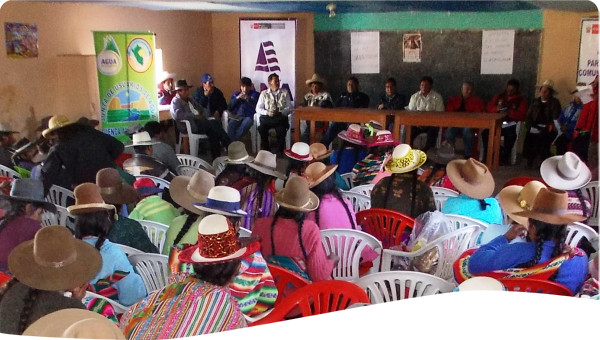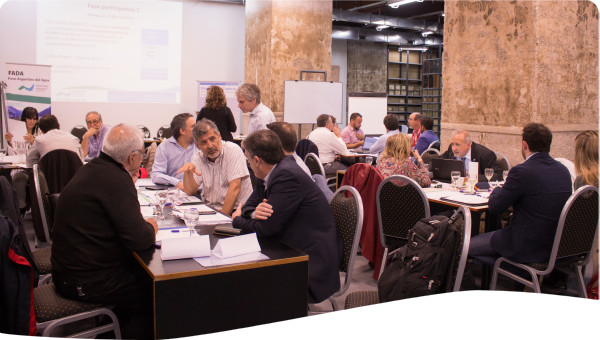Lake Cyohoha and its 508 km2 watershed in the Bugesera region marks the border between Southern Rwanda and Northern Burundi. In the GWP WACDEP climate resilience project, stakeholders analyzed the situation and decided for actions. Drought resistant trees were planted, water points installed and connected to a supply network, fuel saving stoves and biogas was introduced and capacity development events were held.
The Lake Cyohoha transboundary catchment is located in the Bugesera region which is shared by Burundi and Rwanda and is part of the wider Lake Victoria basin. Its characteristic vegetation consists of dry savannas, and wetlands surrounding the rivers and the lake. Due to persistent drought and environmentally unfriendly human practices such as over-cultivation, deforestation and unregulated livestock rearing, the catchment faces problems of soil erosion, water pollution and water scarcity. In addition, both countries are challenged by food insecurity due to small plots of land, poor agricultural practices, land degradation and rapid population growth.
Population growth and the need to sustain livelihoods put pressure on the natural environment. The dependency from agriculture caused over-cultivation there by leading to land degradation, soil erosion and pollution. The area lacks piped water systems and communities depend on the lakes water, with more and more degraded quantity and quality. But it was not only the water and agricultural sector that was challenging people’s life’s. The need to cut trees for firewood as energy sources further degraded the land and diminished sources of wood. All these challenges are increasingly difficult to manage in the transboundary context.
The environmental legislation and enforcement including water resources management vary greatly in Rwanda and Burundi. Rwanda is bound to very strict environmental laws in order to protect freshwater resources in its boundaries while Burundi on the other hand is still at low levels of managing its environment. In the current situation of resource scarcity and environmental degradation, conflicts are likely to arise. Limited management efforts by Burundi to protect the lake may compel Rwandans to take advantage of the lake’s resources without considering issues of sustainability. Also, if the lake continues to shrink and wetlands dry up, conflicts over access to and use of resources could easily cause or aggravate social problems.
The Global Water Partnership is tackling these challenges through its Water, Climate and Development Programme (WACDEP), a program implemented in the Bugesera region which started in 2011.
In this situation, the WACDEP program focuses on adaptation measures at community level aimed at integration of measures into wider policy frameworks with full stakeholder participation in both countries. To address the issues highlighted, the project started with a multidisciplinary group of experts from both countries that carried out a situation analysis and workshops with stakeholders were held to evaluate response measures. The stakeholders were mainly local government representatives, community representatives, technical government officers and the local implementing partners. Stakeholders then agreed on the following actions that were implemented by the communities.
At catchment level, pilot project activities were implemented to enhance water security and climate resilience with such activities that include tree planting, promotion of biogas facilities, energy-saving cooking stoves and an expansion of water supply services. At government level, personnel from ministries and policy makers received training in water security and climate resilience to integrate the project measures into a wider framework of integrated approaches of water management.
To increase land protection and food production, a buffer zone at the lake was established through afforestation of 30 hectares with 36,000 drought resistant trees. The water situation was tackled by 8 new water points connected to 2,500 m of supply network serving around 3,000 people. Additionally, the communities where organized into water committees and trained to manage the water points. To decrease the dependency from firewood and thus decrease deforestation, fuel saving stoves and biogas was introduced. The people were trained to produce 1,000 fuel saving stoves and 11 biogas digesters were installed including rainwater harvesting tanks used to produce biogas.
In addition to these measures, technical capacity development trainings were held. The objective was to learn how to prioritize no and low regret solutions and to make a clear economic case for investment options.
The success of climate adaption and sustainable management depends on stakeholder sensitization. Hence a media training was organized to raise awareness on water security and climate resilience.
As a result of the WACDEP project, a catchment climate adaptation and water resources management plan has been developed for Lake Cyohoha. In the process of developing the plans, no/low regret investment strategies were conceived to enhance water security and climate-resilient development.
The water supply system for communities is anticipated to reach over 3,000 households to provide safe water and, therefore, change the quality of life of the people in the transboundary catchment area.
The construction of biogas digesters is reducing the dependency on natural vegetation for biomass energy thus curbing vegetation destruction. This has increased domestic energy sources and helped curb energy insecurity. Lighting has been installed in houses so that children are now able to do their homework in the evening which is expected to lead to better performance in schools. Improved energy saving stoves are preventing diseases associated with inhaling smoke and thus improving life conditions. The planting of trees in the Lake Cyohoha buffer zone improves vegetation cover there by curbing soil erosion and environmental degradation.
The training of media practitioners and communication officers has resulted in an increased coverage of climate change issues thus increasing the understanding of climate change impacts among communities, local government agencies and other stakeholders. This has strengthened the commitment of stakeholders and supported the successful implementation of WACDEP adaptation activities.
Relating to the WACDEP Communication Strategy trainings, insightful inputs were provided with an emphasis on the need for building on the existing linguistic assets between Rwanda and Burundi and use of community radio stations and other media for communication. A network has been established for the sharing of climate related information and knowledge with the public. This network has enabled the exchange of knowledge products and press information packs. It also helps to coordinate and monitor the activities on the ground.
The WACDEP project is contributing to the overall goal of water security and further addressing vulnerability issues in the catchment which the governments of Burundi and Rwanda are struggling to address.
In summary, the direct impacts of WACDEP include: increased climate resilience of 30,000 catchment inhabitants in both countries, improved living conditions through enhanced energy and water security, protection of Lake Cyohoha from further soil erosion and the establishment of a network for sharing and promoting knowledge on water and climate issues. The interventions have enhanced the adaptive capacity and resilience of the communities and the project has become a role model for the surrounding communities with regards to environmental and water resources protection. It has provided a way for people from both countries to collaborate in managing Lake Cyohoha water and other natural resources.
Linking policies with practice is useful in promoting water security and climate resilience.
Considering the catchment as a unit of management and establishing mechanisms for cooperation in the entire transboundary level increases conservation of resources. Community catchment management structures are critical as they enhance empowerment and ownership and buy-in for tangible results.
Communities need water for various uses, therefore it is important to integrate their concerns into the planned approaches and demonstration activities. This increases ownership of the activities on the part of the communities as access to water becomes easy.
The success of the WACDEP can be attributed to the continuous, meaningful involvement of communities and all relevant stakeholders in both countries. Early participation and ownership are needed for the sustainability of a project and provide lessons for future replication.
Solving water problems is not only a task for the water sector. It requires interventions in water-using sectors such as agriculture, the energy, industry etc. The impacts
 Case studies
Case studies




